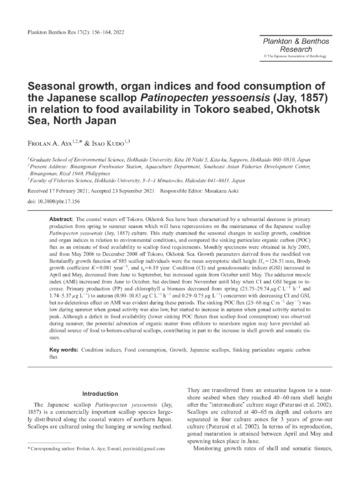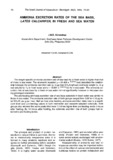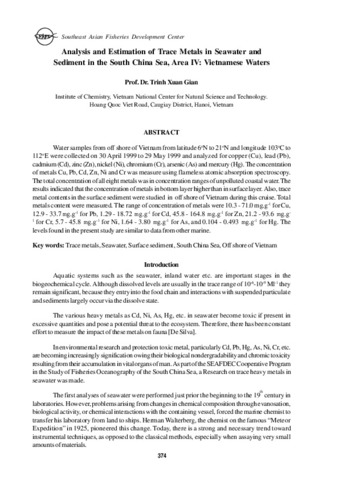| dc.contributor.author | Aya, Frolan | |
| dc.contributor.author | Kudo, Isao | |
| dc.coverage.spatial | Okhotsk, Sea of | en |
| dc.date.accessioned | 2022-08-15T02:11:51Z | |
| dc.date.available | 2022-08-15T02:11:51Z | |
| dc.date.issued | 2022-09 | |
| dc.identifier.citation | Aya, F. A., & Kudo, I. (2022). Effect of water mass mixing on phytoplankton dynamics in the scallop culture areas off Okhotsk Sea: A microcosm experiment. Regional Studies in Marine Science, 55, 102568. https://doi.org/10.1016/j.rsma.2022.102568 | en |
| dc.identifier.uri | http://hdl.handle.net/10862/6350 | |
| dc.description.abstract | The nearshore (Soya Warm Water (SWW)) and offshore (Intermediate Cold Water (ICW) and Okhostk Sea Low Salinity Water (OSLSW)) waters in the Okhotsk Sea differ substantially in their physico-chemical characteristics. Thus, the extent to which water mass mixing impacts phytoplankton dynamics in the Japanese scallop Patinopecten yessoensis culture areas needs to be assessed to properly manage scallop stocks. This study examined the phytoplankton dynamics in nearshore (SWW) and offshore (ICW and OSLSW) waters and phytoplankton response to water mass mixing (SWW + ICW, OSLSW + ICW) for 5 days in spring (2007) and summer (2007–2009) microcosm experiments. Increased chlorophyll a concentration in ICW was observed due to higher nutrients available for phytoplankton uptake than in OSLSW and SWW at the start of each microcosm experiment. In comparison to spring microcosm, mixing of SWW + ICW promoted higher chlorophyll a concentration and faster Si(OH)4 utilization than in OSLSW + ICW in summer. In addition, the size structure of chlorophyll a differed from micro-size (>) in SWW + ICW to nano-size (<) chlorophyll a in OSLSW + ICW. Suspended particulate organic matter (SPOM) \(\mathsf{\delta^{13}C}\) ratios were positively correlated with chlorophyll a in both mixed microcosms whereas SPOM \(\mathsf{\delta^{15}N}\) isotopic ratios were inversely related to nitrate concentration in SWW + ICW, except in spring. This suggests that stable isotopes can be used in predicting phytoplankton biomass and nutrient utilization. In comparison to microcosm experiments, nearshore water column structure suggests vertical water mixing in summer to autumn when phytoplankton biomass and micro-size fraction were at maximum. Taken together, the advance of nutrient-rich ICW to nutrient-poor nearshore areas in the Okhotsk Sea resulted in increased chlorophyll a biomass and dominance of micro-size phytoplankton in summer, potentially enhancing nutrient and food supply to bottom-cultured scallops as suggested by both microcosm experiments and field observations. | en |
| dc.description.sponsorship | This study was supported by research grants from the Hokusui Society Foundation to I. Kudo, and the Ministry of Education, Culture, Sports, Science and Technology, Japan to F.A. Aya. | en |
| dc.language.iso | en | en |
| dc.publisher | Elsevier | en |
| dc.subject | Patinopecten yessoensis | en |
| dc.subject | scallops | en |
| dc.title | Effect of water mass mixing on phytoplankton dynamics in the scallop culture areas off Okhotsk Sea: A microcosm experiment | en |
| dc.type | Article | en |
| dc.citation.volume | 55 | |
| dc.citation.spage | 102568 | |
| dc.citation.journalTitle | Regional Studies in Marine Science | en |
| dc.subject.asfa | water masses | en |
| dc.subject.asfa | phytoplankton | en |
| dc.subject.asfa | scallop culture | en |
| dc.subject.asfa | microcosms | en |
| dc.identifier.essn | 2352-4855 | |
| dc.identifier.doi | 10.1016/j.rsma.2022.102568 | |
| dc.subject.scientificName | Patinopecten yessoensis | en |
| local.subject | Nutrients | en |
| local.subject | Chlorophyll a | en |
| local.subject | Particulate organic matter | en |
| local.subject | Soya Warm Water | en |
| local.subject | Sea of Okhotsk | en |



